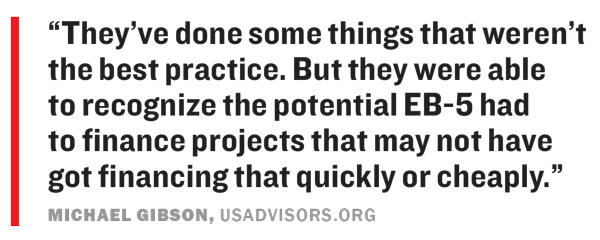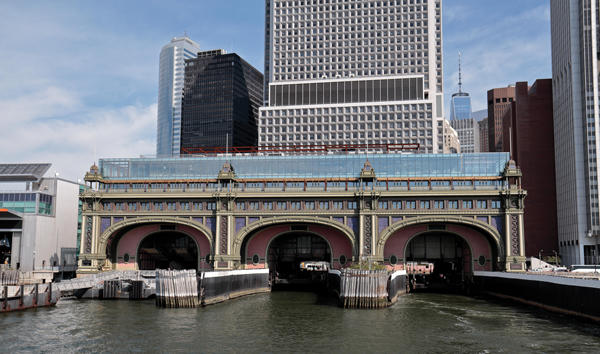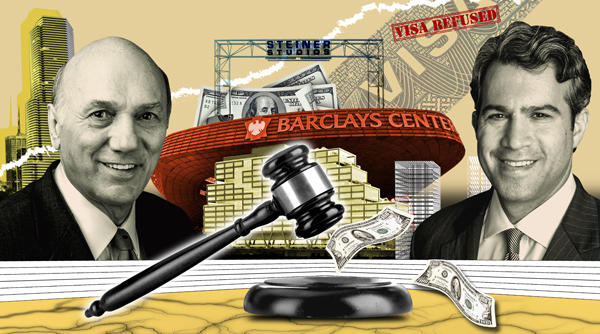Michael Gibson, a Miami investment adviser, was hosting clients at his booth in the Las Vegas Convention Center when he became bothered by two men conducting their own business in his quarters.
Gibson was at the 2009 American Immigration Lawyers Association annual conference to promote his advisory service for the EB-5 “cash-for-visa” program, and his booth was busy with developers and attorneys looking to fund real estate projects with cheap foreign capital.
The two men standing in his space, George Olsen and Paul Levinsohn, had recently launched their own EB-5 firm in New York to manage capital on behalf of overseas investors and were seeking connections to help fund their first projects.
Related: Chinese investors want their money back
“You guys gotta go,” Gibson recalled telling the pair.
Olsen and Levinsohn launched their firm, the New York City Regional Center, 10 years ago with just $300,000. Since then the company has raised over $1.5 billion in foreign capital to fund 21 real estate and infrastructure projects across the city, while securing more than 4,500 green cards for foreigners, according to its website.
Among the 903 regional centers designated by the federal government, as of June 2018, NYCRC is considered one of the most prolific EB-5 conduits in the country.
“You owe it to yourself and your family to select a regional center with a proven track record of success,” Levinsohn says in a video to promote one of the firm’s recent loan agreements — a CityBridge project to replace pay phones with LinkNYC Wi-Fi kiosks.
But the company’s reputation is being tested by two ongoing lawsuits that allege the regional center has defrauded investors and refused to pay an overseas migration firm that sent hundreds of investors to NYCRC.
Olsen, Levinsohn and their firm are accused of breaching their fiduciary duty to more than 100 Chinese investors who provided $77 million for a project the regional center continued to market even though the developer had defaulted on its loan repayments. The investors claim NYCRC used their money to fund the project without commitment from the developer and the city, while it received millions in annual fees and interest.
To raise capital for infrastructure improvements around Forest City’s Barclays Center project in 2010, the firm attracted Chinese migration agents with increasingly higher commissions. In an ongoing case brought by one of these agents, the regional center is accused of refusing to pay almost $10 million in commissions for that project and several others.
 “They’ve done some things that weren’t the best practice,” Gibson, whose advisory website monitors EB-5 litigation, told The Real Deal. “But they were able to recognize the potential EB-5 had to finance projects that may not have got financing that quickly or cheaply.”
“They’ve done some things that weren’t the best practice,” Gibson, whose advisory website monitors EB-5 litigation, told The Real Deal. “But they were able to recognize the potential EB-5 had to finance projects that may not have got financing that quickly or cheaply.”
U.S. Citizenship and Immigration Services, which oversees the visa program under the Department of Homeland Security, said in a statement that it does not discuss specific regional centers due to “privacy protections.”
Olsen and Levinsohn declined to respond to a detailed list of questions for this article. In reference to the ongoing lawsuits, a lawyer representing their firm wrote in an email: “It is our position that both cases lack merit and that NYCRC will prevail in the litigations.”
From sticks to bricks
Congress launched the EB-5 program in 1990 to help attract foreign entrepreneurs and stimulate the economy, particularly in areas of low employment and rural communities. In exchange for green cards, foreigners invest between $500,000 and $1 million in enterprises that create at least 10 jobs.
Regional centers were introduced three years later to act as conduits between investors and developers seeking to pool funding for larger projects.
The program remained under the radar for the next 15 years and was used mostly to provide funding for infrastructure projects. When NYCRC’s founders sought to establish their firm in 2007, there were just 11 regional centers, according to a Reuters report. But the visa program was about to explode with interest from real estate as the financial crisis unfolded.
Olsen, a developer and attorney, was building condominiums in Tribeca when Sandra Dyche Kim, a Korean-American developer involved in one of the sites, floated the idea of starting a regional center. Olsen then approached Mona Shah, an immigration attorney with knowledge of the EB-5 program who worked in the office next door to him.
The trio founded Empire Gateway LLC, which would later become NYCRC’s parent company. Under their agreement, Kim would use her connections in Korea to pool investors, Olsen would secure projects in New York to invest in, and Shah would take care of the legal work.
“We needed more capital than we had,” Shah said in a recent interview. “At which case George brought his friend, who was Paul.”
Levinsohn, a businessman who owned an apartment above Olsen on Chambers Street, told the group of his work in government and his success in owning several companies, Shah recalled.
It was true that Levinsohn had worked in public service. In 2001, he served as campaign finance chairman and then chief counsel to former New Jersey Gov. James E. McGreevey. However, Levinsohn resigned on Jan. 1, 2003, after the FBI probed a billboard business he and the governor’s chief of staff, Gary Taffet, sold days before being sworn in, amid allegations that the pair had profited from their political connections. The investigation led to the conviction of former New Jersey state Sen. John Lynch, who pled guilty to taking kickbacks. But there is no evidence of any action being taken against Levinsohn.

Investors in the Battery Maritime Building claim NYCRC used their $77 million to fund the project without commitment from the developer and city.
McGreevey wrote in an email to TRD that Levinsohn was an “exceptional public servant.”
While that inquiry continued for several years, Levinsohn returned to the private sector and bought a stake in Uni-Mart, a gas and convenience-store chain with more than 290 stores, before selling out in 2008 — the same year he joined NYCRC. Uni-Mart owed $28.5 million to creditors when it filed for bankruptcy the same year.
Levinsohn bought a 45 percent stake in the regional center under a separate LLC and was made a principal at the firm. But he remained active in other businesses, and in 2009 took on a principal role at a vitamin company that sold memory improvement pills for seniors at Walmart and CVS.
The vitamin company later settled a federal lawsuit that claimed it falsely marketed the product as being patented.
The Chinese connection
In October 2008, mere weeks after the global stock markets crashed, the New York City Regional Center received approval to operate from the federal immigration services agency.
In the wake of the financial crisis, USCIS redefined the EB-5 program’s regulatory language to allow the required “10 permanent jobs” to also include temporary construction jobs. This opened the floodgates for developers looking for low-interest capital to use EB-5 money for their projects in the absence of traditional bank loans.
Olsen and Levinsohn, by now, were seeking to raise $135 million for their first two projects: the Brooklyn Navy Yard and Steiner Studios, which was set to be the largest production complex outside Hollywood.
“They’re responsible for the first large mainstream deals in New York City,” said Clem Turner, a Manhattan immigration attorney who specializes in the EB-5 program and has dealt with the pair. “They entered in a big way.”
China, a largely untapped investor market at the time, was unique in that investors were required to enlist in overseas investor programs through migration agents approved by the Chinese government. The uptick in EB-5 transactions soon presented an opportunity for these agents to reap hefty commissions on U.S. developments.
With little traction from Kim’s Korean connections, Olsen and Levinsohn were introduced to the Chinese investor market through another New Yorker familiar with the EB-5 program. Chaim Katzap, who ran his own advisory firm, Lion’s Property Development Group, and had connections to Chinese migration agents, first met Olsen in May 2009, according to court filings.
At the time, regional centers made earnings on the back end with interest between 3 and 5 percent for each $500,000 investment, while immigration agents overseas were paid an administration fee, up to $30,000 per investor. In order to attract overseas agents and their investors, Olsen and Levinsohn began offering these agents a share in the percentage points on top of the administration fees, according to Shah.
“It was very cutthroat,” Shah said. “And the market was still very gentle.”
Katzap shared with the pair his own exclusive list of Chinese agents who could pool investors for their first projects. He was to be paid $30,000 per investor, which he would split with the agents in China, according to a lawsuit Katzap filed in April 2011. But Olsen and Levinsohn’s firm “had a plan to use Lion’s Property’s work without paying for it” and dealt directly with the agents, cutting Katzap out of any future deals, the suit claimed.
Katzap declined to comment for this article, citing a confidentiality agreement and settlement.
Once NYCRC’s initial projects were underway, Olsen bought out Kim’s interests in the company, and Shah said her investment was returned. In August 2011, Olsen filed a lawsuit that accused Kim of failing to attract any investors. In her counterclaim, Kim alleged that she had been forced out of the company and blocked from buying Shah’s share in Empire Gateway, which would give her a majority stake. The case was later discontinued. Kim did not return calls for this article.
“It was bitter,” Shah said. “I was forced out through constructive eviction.”
A trail of litigation
Despite a turbulent start, Olsen and Levinsohn’s firm soon locked down a flurry of projects across New York, including a phase of the $5 billion Atlantic Yards megadevelopment. Forest City’s plan was to build more than 6,000 affordable rental units and market-rate condos, infrastructure including a new subway entrance, and the Barclays Center on top of the Long Island Rail Road yards in Downtown Brooklyn.
“Atlantic Yards was, by far, the largest project anybody had seen [in the EB-5 program],” Gibson said.
The project had been mired in delays since it was announced in 2003 — due to multiple land seizure lawsuits and the financial crisis. But under its agreement with NYCRC in 2011, a Forest City affiliate sought $228 million in additional financing to keep moving forward. With little time to raise such an unprecedented amount of EB-5 capital, the regional center launched a mass marketing campaign overseas.
In Korea, one migration agent hired by NYCRC told investors that their money would be used to fund the construction of an arena — the Barclays Center, future home of the New Jersey Nets NBA team — and that their green cards were “guaranteed,” according to a 2010 Reuters report. But the marketing pitch was not totally true. The funding would go toward infrastructure near the Barclays Center, and green cards cannot be guaranteed under the EB-5 program because investments must be “at risk.” Olsen told Reuters that the agent had misrepresented the project.
“To raise $100 million, you have to get 200 investors,” he told the news agency. “So there’s a certain amount of mass marketing that has to go on.”
The same year, Olsen and Levinsohn secured an agreement to provide capital for the Battery Maritime Building, a rundown government-owned ferry terminal at the southern tip of Manhattan.
The developer, the Dermot Company, had secured a contract with the city to revamp the landmarked site and build a hotel, restaurant and community space. In marketing documents used to solicit investors, the regional center claimed it would provide a $77 million construction loan, while $17 million would come from Dermot and $145 million would be provided by the city’s Economic Development Corporation, the site’s owner.
But there was no commitment from Dermot, since the agreement came from an affiliated shell company that had no assets. And the money to be contributed by the city was not for the Maritime Building but for work on the East River Esplanade, according to an ongoing lawsuit filed by the investors in April 2017.
Dermot had completed roughly 60 percent of the project by mid-2015 when it defaulted on its loan repayments to the regional center and stopped paying rent to the city, according to the lawsuit. Yet Olsen and Levinsohn’s firm continued to market the project overseas. In a newsletter issued to investors that August, the regional center documented the progress of construction and stated that one of the final steps was “in progress.”
Both the city and the regional center sued the developer in the following months, but the investors’ suit claims Olsen and Levinsohn’s firm did not inform them that their investment was in jeopardy until more than a year later, in October 2016. By then, NYCRC had earned a $1.5 million origination fee and a 2 percent annual management fee, while the loan generated $3.6 million interest per year, according to the complaint.
The investors’ suit also alleges that NYCRC has refused to accept offers from other developers to take on the project unless the investors drop their claims.
“It appears they didn’t observe the standards a conventional lender would apply,” said Gary Friedland, a scholar-in-residence at NYU Stern who analyzed the case in a December report for the school’s Center for Real Estate Finance Research. “If the court rules that the regional center is liable, this could indicate that other EB-5 lenders are lax in their loan administration standards, given that the NYCRC is one of the largest and most experienced in the country.”
Friedland told TRD that the regional center was incentivized to continue investing in the project, regardless of guarantees by the developer, because it would earn interest on the loan.
The Maritime Building and arena infrastructure project, as well as the Brooklyn Navy Yard and Steiner Studios, are now the center of a federal lawsuit brought against the regional center by one of the largest migration agents in China, Wailian Overseas Consulting Group. The agent claims it is owed $9.4 million in unpaid commissions after it directed 460 investors to NYCRC, raising $250 million for eight separate projects. The regional center is due to respond to an amended complaint by July 9.
But Olsen and Levinsohn appear undeterred by the lawsuits circling their firm. In January, the regional center received a green light to raise $55 million for the second phase of construction on the new South Bronx headquarters for online food grocer Fresh Direct.
Shah, meanwhile, continues to work as an immigration attorney involved in EB-5 transactions and has watched the firm she co-founded from afar.
“They’ve managed to get out of many different scraps,” she said. “And they’ve made their money. Not always in the correct way.”




